
Halloween or Hallowe'en (a contraction of All Hallows' Evening), also known as Allhalloween, All Hallows' Eve,or All Saints' Eve, is a celebration observed in a number of countries on October 31, the eve of the Western Christian feast of All Hallows' Day. It begins the three-day observance of Allhallowtide, the time in the liturgical year dedicated to remembering the dead, including saints (hallows), martyrs, and all the faithful departed.

It is widely believed that many Halloween traditions originated from ancient Druid/Celtic harvest festivals, particularly the Gaelic festival Samhain; that such festivals may have had pagan roots; and that Samhain itself was Christianized as Halloween by the early Church. Some believe, however, that Halloween began solely as a Christian holiday, separate from ancient festivals like Samhain.

Like many other holidays, Halloween has evolved and changed throughout history. Over 2,000 years ago people called the Celts lived in what is now Ireland, the UK, and parts of Northern France. November 1 was their New Year's Day. They believed that the night before the New Year (October 31) was a time when the living and the dead came together.

More than a thousand years ago the Christian church named November 1 All Saints Day (also called All Hallows.) This was a special holy day to honor the saints and other people who died for their religion. The night before All Hallows was called Hallows Eve. Later the name was changed to Halloween.

Like the Celts, the Europeans of that time also believed that the spirits of the dead would visit the earth on Halloween. They worried that evil spirits would cause problems or hurt them. So on that night people wore costumes that looked like ghosts or other evil creatures. They thought if they dressed like that, the spirits would think they were also dead and not harm them. They went door to door begging for cakes to appease the dead.
When Halloween was brought over to America, children saw it as a day for mischief.


These days Halloween is not usually considered a religious holiday. It is primarily a fun day for children. Children dress up in costumes like people did a thousand years ago. But instead of worrying about evil spirits, they go from house to house hoping for candy. They knock on doors and say "Trick or Treat." In other words - "Give me a Treat or I'll create Mischief".

The Bible does not mention Halloween. However, both the ancient origins of Halloween and its modern customs show it to be a celebration based on false beliefs about the dead and invisible spirits, or demons.—See “Halloween history and customs.”
The Bible warns: “There must never be anyone among you who . . . consults ghosts or spirits, or calls up the dead.” (Deuteronomy 18:10-12, The Jerusalem Bible) While some view Halloween as harmless fun, the Bible indicates that the practices associated with it are not. At 1 Corinthians 10:20, 21, the Bible says: “I do not want you to be participants with demons. You cannot drink the cup of the Lord and the cup of demons too.”—New International Version.
The Halloween we celebrate today includes all of these influences, Pomona Day’s apples, nuts, and harvest, the Festival of Samhain’s black cats, magic, evil spirits and death, and the ghosts, skeletons and skulls from All Saint’s Day and All Soul’s Day.


Why do American's love Halloween? Perhaps because it brings them back to their youth. Of Trick or Treating and sharing that Tradition with their children?
People also enjoy feeling scared and seek that feeling out because, deep down, they know they are in no real danger. They understand the real risk of these activities is marginal, and because of this underlying awareness, they experience excitement rather than actual fear. This is why people enjoy going on terrifying amusement park rides and walking through a Halloween-themed haunted house.

Most adults and teenagers are able to realistically gauge the actual level of threat that scary stimuli pose to them, and, correspondingly, their safety level. For example, watching a horror movie poses no physical threat, with the minor psychological threat being that they might have nightmares as a result of seeing it. Therefore, most viewers feel safe watching such a film, and are excited by it, not truly afraid. We are all Thrill Seekers, alike.

Posted from my blog with SteemPress : https://sinfullyvin.com/halloween-history-an-american-tradition/
Hi! I am a robot. I just upvoted you! I found similar content that readers might be interested in:
http://5minuteenglish.com/oct29.htm
Downvoting a post can decrease pending rewards and make it less visible. Common reasons:
Submit